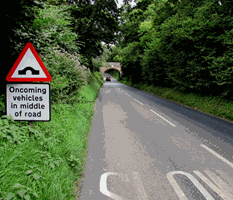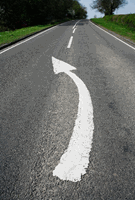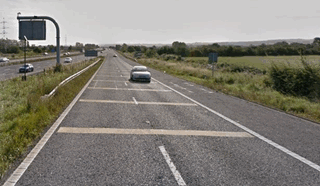The Alertness Theory Test consists of 28 questions.
You need 24 out of 28 (86%) to pass. There is no time limit for this test.
Click here to read our Alertness Theory Test revision notes.
There are no tests related to this category :
There are no tests related to this category :
Quick view of test questions. Click question box to reveal correct answer.
Correct Answer: A
Explanation: Before you perform a U-turn, slow down and have a look to see if the road is clear in both directions. Ensure there is enough space in the road to safely perform the manoeuvre.
Explanation: Before you perform a U-turn, slow down and have a look to see if the road is clear in both directions. Ensure there is enough space in the road to safely perform the manoeuvre.
Correct Answer: C
Explanation: Slow down and exercise caution. The bridge is narrow, so passing an oncoming vehicle may not be possible. There is also no footpath, so keep an eye out for pedestrians in the road.
Explanation: Slow down and exercise caution. The bridge is narrow, so passing an oncoming vehicle may not be possible. There is also no footpath, so keep an eye out for pedestrians in the road.
Correct Answer: D
Explanation: Prior to overtaking, consider if it’s really needed. If you can’t see far enough, keep back and wait for a better place to pull out.
Explanation: Prior to overtaking, consider if it’s really needed. If you can’t see far enough, keep back and wait for a better place to pull out.
Correct Answer: B
Explanation: The road marking displayed in this image indicates that overtaking drivers or riders need to shift to the left before they reach the hatch markings. Hatch markings are used to separate traffic lanes. For example, when approaching some junctions or dual carriageways.
Explanation: The road marking displayed in this image indicates that overtaking drivers or riders need to shift to the left before they reach the hatch markings. Hatch markings are used to separate traffic lanes. For example, when approaching some junctions or dual carriageways.
A
B
C
D
B
C
D
Correct Answer: B
Explanation: Using a mobile phone or a similar device while driving or riding is against the law, except in the case of an emergency. For your safety, you should switch off your mobile phone before leaving and set it to voice mail. If your phone rings because you forgot to turn it off, ignore it. When you've come to a safe stop, you can check your phone and, if necessary, return the call.
Explanation: Using a mobile phone or a similar device while driving or riding is against the law, except in the case of an emergency. For your safety, you should switch off your mobile phone before leaving and set it to voice mail. If your phone rings because you forgot to turn it off, ignore it. When you've come to a safe stop, you can check your phone and, if necessary, return the call.
Correct Answer: D
Explanation: These lines are a form of traffic calming measure. They are often present just before roundabouts and dangerous junctions. They prompt you to reduce your speed. You should look ahead and do this in good time.
Explanation: These lines are a form of traffic calming measure. They are often present just before roundabouts and dangerous junctions. They prompt you to reduce your speed. You should look ahead and do this in good time.
7. You're approaching a set of traffic lights which have been on green for some time. What should you do?
Mark one answer
AB
C
D
Correct Answer: B
Explanation: Always consider when approaching traffic lights on green that they could change to red. Be prepared in case they change and you have to stop, especially if the lights have been green for a while.
Explanation: Always consider when approaching traffic lights on green that they could change to red. Be prepared in case they change and you have to stop, especially if the lights have been green for a while.
Correct Answer: A
Explanation: Before pulling over or coming to a stop, always check your mirrors to see who is behind you. Don't forget to use your indicators if pulling off or stopping by the road.
Explanation: Before pulling over or coming to a stop, always check your mirrors to see who is behind you. Don't forget to use your indicators if pulling off or stopping by the road.
9. You're driving behind an LGV (Large Goods Vehicle). Why should you keep well back?
Mark one answer
AB
C
D
Correct Answer: B
Explanation: LGV and van drivers don't have rear view mirrors. Remember to stay well back from them, because if you can't see their side mirrors, they can't see you. This will also help you see more of the road.
Explanation: LGV and van drivers don't have rear view mirrors. Remember to stay well back from them, because if you can't see their side mirrors, they can't see you. This will also help you see more of the road.
Correct Answer: A
Explanation: You should be checking your mirrors regularly, ensuring you always know what's ahead, beside, and behind you. Doing this will help you anticipate what might happen next, helping avoid and prevent hazards. It's especially important to check your mirrors when you spot a hazard.
Explanation: You should be checking your mirrors regularly, ensuring you always know what's ahead, beside, and behind you. Doing this will help you anticipate what might happen next, helping avoid and prevent hazards. It's especially important to check your mirrors when you spot a hazard.
11. You intend to turn right at a junction but your view is blocked by parked vehicles. What should you do?
Mark one answer
AB
C
D
Correct Answer: D
Explanation: Buildings, parked cars, and trees often restrict visibility at junctions. To ensure emerging is safe, creep forward slowly to look past obstructions. Ensure you don't cause other drivers to change speed when you pull out.
Explanation: Buildings, parked cars, and trees often restrict visibility at junctions. To ensure emerging is safe, creep forward slowly to look past obstructions. Ensure you don't cause other drivers to change speed when you pull out.
Correct Answer: A
Explanation: Anything dangling from your rear view mirror or stuck to your windscreen could distract you from driving properly. Make sure you can see through your windscreen clearly.
Explanation: Anything dangling from your rear view mirror or stuck to your windscreen could distract you from driving properly. Make sure you can see through your windscreen clearly.
A
B
C
D
B
C
D
Correct Answer: B
Explanation: Fresh air can help keep you alert when you begin to feel tired, but your first priority should always be using the next service area or motorway exit to find a safe place to rest.
Explanation: Fresh air can help keep you alert when you begin to feel tired, but your first priority should always be using the next service area or motorway exit to find a safe place to rest.
14. It starts to get dark while you're driving. Why should you switch on your lights?
Mark one answer
AB
C
D
Correct Answer: D
Explanation: When visibility is poor during the day, it may be necessary to turn on your headlights and tail lights to help other drivers spot you. This is especially true in early morning or in late afternoon, when the operation of streetlamps might not be timed optimally to help drivers see clearly.
Explanation: When visibility is poor during the day, it may be necessary to turn on your headlights and tail lights to help other drivers spot you. This is especially true in early morning or in late afternoon, when the operation of streetlamps might not be timed optimally to help drivers see clearly.
A
B
C
D
B
C
D
Correct Answer: D
Explanation: Tuning your radio stations to local radio, planning your route, and taking regular breaks are just a few ways you should prepare for a long journey. Avoid distractions as much as possible. Handheld mobile phone use is illegal except in emergencies, but even hands-free use can be distracting.
Explanation: Tuning your radio stations to local radio, planning your route, and taking regular breaks are just a few ways you should prepare for a long journey. Avoid distractions as much as possible. Handheld mobile phone use is illegal except in emergencies, but even hands-free use can be distracting.
16. In which of the following situations are you permitted to use a mobile phone in your car?
Mark one answer
AB
C
D
Correct Answer: A
Explanation: Except in genuine emergencies, it is illegal to use a handheld mobile phone. Hands-free kits make phone use possible, but are still distracting. The safest approach is to stop in a safe place before making or receiving a call. Your hands will also be free to take notes if needed.
Explanation: Except in genuine emergencies, it is illegal to use a handheld mobile phone. Hands-free kits make phone use possible, but are still distracting. The safest approach is to stop in a safe place before making or receiving a call. Your hands will also be free to take notes if needed.
17. While driving on a wet road, you suddenly need stop the car due to an emergency. What should you do to keep safe?
Mark one answer
AB
C
D
Correct Answer: B
Explanation: Paying attention to your surroundings makes it more likely you'll spot hazards early. This means you'll react earlier too, and can keep better control of the vehicle in emergencies. Ensure you keep both hands on the steering wheel to maximise control.
Explanation: Paying attention to your surroundings makes it more likely you'll spot hazards early. This means you'll react earlier too, and can keep better control of the vehicle in emergencies. Ensure you keep both hands on the steering wheel to maximise control.
A
B
C
D
B
C
D
Correct Answer: A
Explanation: You should check your exterior and interior mirrors to make sure the road is clear before moving off. Check your blind spots too, and be prepared to use arm signals if you feel other drivers might not understand your intentions.
Explanation: You should check your exterior and interior mirrors to make sure the road is clear before moving off. Check your blind spots too, and be prepared to use arm signals if you feel other drivers might not understand your intentions.
19. You're driving on a narrow country road and see a cyclist ahead. How should you pass?
Mark one answer
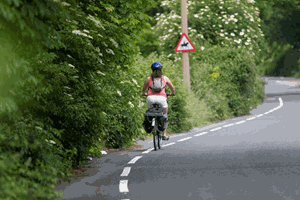
B
C
D
Correct Answer: B
Explanation: Cyclists often need to weave around potholes, and sometimes need to adjust their course to correct their balance. Allow them plenty of room when you overtake, and pay close attention to the road ahead, looking for farm entrances or driveways where vehicles might pull out.
Explanation: Cyclists often need to weave around potholes, and sometimes need to adjust their course to correct their balance. Allow them plenty of room when you overtake, and pay close attention to the road ahead, looking for farm entrances or driveways where vehicles might pull out.
Correct Answer: D
Explanation: Except in genuine emergencies, it is illegal to use a handheld mobile phone. Doing so will distract you from the road, and increase risk of an accident.
Explanation: Except in genuine emergencies, it is illegal to use a handheld mobile phone. Doing so will distract you from the road, and increase risk of an accident.
Correct Answer: D
Explanation: You should always find a safe place to stop before checking a map or asking for directions.
Explanation: You should always find a safe place to stop before checking a map or asking for directions.
22. In which of the following situations would windscreen pillars hinder your view of the road?
Mark one answer
AB
C
D
Correct Answer: A
Explanation: Smaller vehicles and road users - pedestrians, motorcyclists, and cyclists - can be hidden by your windscreen pillars. Be sure to move your head to look past them to check the road at bends and junctions.
Explanation: Smaller vehicles and road users - pedestrians, motorcyclists, and cyclists - can be hidden by your windscreen pillars. Be sure to move your head to look past them to check the road at bends and junctions.
A
B
C
D
B
C
D
Correct Answer: A
Explanation: Ensure you can see all around your vehicle before attempting to turn your car around. Get someone to guide you if you're unable to get a good look around.
Explanation: Ensure you can see all around your vehicle before attempting to turn your car around. Get someone to guide you if you're unable to get a good look around.
Correct Answer: A
Explanation: Even modern vehicles have blind spots, areas of the vehicle's surroundings not visible through its mirrors. It's therefore essential that you look around to check these areas are clear when necessary.
Explanation: Even modern vehicles have blind spots, areas of the vehicle's surroundings not visible through its mirrors. It's therefore essential that you look around to check these areas are clear when necessary.
Correct Answer: B
Explanation: Even using a hands-free kit can leave you distracted. The person speaking on the other end of the phone can't see the road you're driving and won't know when you need to concentrate, or when a hazard presents itself. The best course of action is to stop in a safe place before making or taking a call.
Explanation: Even using a hands-free kit can leave you distracted. The person speaking on the other end of the phone can't see the road you're driving and won't know when you need to concentrate, or when a hazard presents itself. The best course of action is to stop in a safe place before making or taking a call.
Correct Answer: B
Explanation: You should ensure the central reservation is deep enough to protect your vehicle before emerging right onto a dual carriageway. If it's not, treat the dual carriageway as a single road, and ensure you check both directions before emerging. Not doing this could cause a collision by placing some or all of your vehicle in the path of approaching traffic.
Explanation: You should ensure the central reservation is deep enough to protect your vehicle before emerging right onto a dual carriageway. If it's not, treat the dual carriageway as a single road, and ensure you check both directions before emerging. Not doing this could cause a collision by placing some or all of your vehicle in the path of approaching traffic.
27. The windscreen pillar is hindering your view at a junction. Which of the following vehicles should you particularly keep an eye out for?
Mark one answer
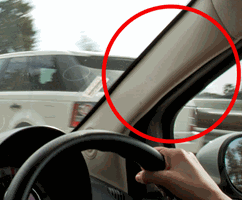
B
C
D
Correct Answer: D
Explanation: Approaching motorcyclists, pedestrians, and cyclists can be entirely obscured by windscreen pillars. Take extra time to look for these road users. Don't assume a quick glance is enough.
Explanation: Approaching motorcyclists, pedestrians, and cyclists can be entirely obscured by windscreen pillars. Take extra time to look for these road users. Don't assume a quick glance is enough.
28. How should you use a satellite navigation device (sat nav) without it affecting your driving?
Mark one answer
AB
C
D
Correct Answer: B
Explanation: Satellite navigation systems (sat nav) are very useful for unfamiliar journeys, but they can also be distracting. Looking at them could cause you to lose control or miss a hazard ahead. Ensure you're stopped in a safe place before attempting to input information or adjust them.
Explanation: Satellite navigation systems (sat nav) are very useful for unfamiliar journeys, but they can also be distracting. Looking at them could cause you to lose control or miss a hazard ahead. Ensure you're stopped in a safe place before attempting to input information or adjust them.


